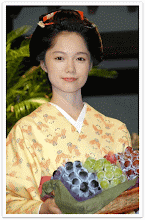Noh Theater is as unique an art form as it is a cultural treasure of Japan known the world over. This musical drama best known for it's exquisite beauty, rich costumes, and array of masks are steeped in symbolism that conjures an era long past to the 13th Century predating Kabuki. We at American Mishima have been fortunate enough to have seen a few Noh Theater performances here in the City of Los Angeles, but these opportunities are rare. It was by chance that we were fortunate enough to attend the Japan Foundation's recent lecture on Noh this last March 13th at their Wilshire Blvd location. The lecture would be for the most part conducted in Japanese by famed Noh Performer Tatsushige Udaka and translated by his wife & Noh Performer Haruna Tanaka. In his lecture, Mr. Udaka shared his vast knowledge of Noh's place in Japanese history and its cultural significance. In this lecture attendee's were given a rare opportunity to pass around sample swatches of the material that is most widely used in Noh Costumes as well as closeup views to the elaborate costumes that span over 100 years in age.
Mr. Udaka talked at length as to the usage of the famous Noh Masks which later made for an entertaining question and answer session in which we had to ask about the actors personal association with their characters. Most particular of interest was that of the famed "Oni" (Demon) mask made famous by the 1964 film Onibaba in which a jealous mother poses as a demon to scare her wayward daughter into submission.
What struck us was his explanation that unlike here in the West, the demon mask represents the state of the heart and not an actual demon. This is not to discount actual belief in such entities but rather to further exemplify the expression of pure jealousy. Traditionally, the demon mask represents the jealous rage of a beautiful woman whose heart reveals her ugliness. When asked about tales of possession, Mr. Udaka recalled one famous story of a Noh Performer who once became so entranced by the demon mask that he cut his own face off to better fit the undersized mask. Such tales are the rare exception but for us it was an opportunity to get the actor's perspective on the lore of the fearsome mask.
 While it wasn't our intention to scare anyone with our provocative questions, we did walk away with a better grasp of how Noh Performers embody such expression through musical chants and rhythmic movements. This is accomplished through their dance as such demonstrated by Mr. Udaka who demonstrated four sample play pieces including the famous "Death of a Samurai" all without masks and with him doing the accompanying chants normally reserved for the musicians that provide the music during a Noh Performance. He danced with such precise single Zen like focus achieving the conveyed implications of the drama which dramatically unfolded like the gilded folding fans used for props, one could see the intensity of the play's lasting impressions of this ancient theater that where only the dancer is on stage. As best explained by Mr. Udaka: "The best I can compare Noh to is that of the modern day experience many people have had searching for the television remote. You will focus on nothing else until you find that remote. That is what it is like to be a Noh Performer."
While it wasn't our intention to scare anyone with our provocative questions, we did walk away with a better grasp of how Noh Performers embody such expression through musical chants and rhythmic movements. This is accomplished through their dance as such demonstrated by Mr. Udaka who demonstrated four sample play pieces including the famous "Death of a Samurai" all without masks and with him doing the accompanying chants normally reserved for the musicians that provide the music during a Noh Performance. He danced with such precise single Zen like focus achieving the conveyed implications of the drama which dramatically unfolded like the gilded folding fans used for props, one could see the intensity of the play's lasting impressions of this ancient theater that where only the dancer is on stage. As best explained by Mr. Udaka: "The best I can compare Noh to is that of the modern day experience many people have had searching for the television remote. You will focus on nothing else until you find that remote. That is what it is like to be a Noh Performer."
We at American Mishima would like thank Mr. Tatsushige Udaka and his wife Haruna Tanaka as well as the Japan Foundation for making this event possible.
To find out about future events sponsored by the Japan Foundation,
Please visit their website at


























